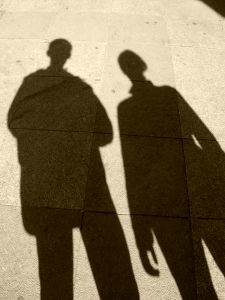 In the Polish town of Jedwabne on July 10, 1941 half the town murdered the other half. Of 1600 Jews, about a dozen survived. In his book Neighbors (2001) Professor Jan Gross was seeking the answer to what we know to be an incident of the collective projection of the shadow. The NYU professor speaking about his book reveals that he was not aware of the underlying cause of this all too common human behavior. “This is a rather typical book about the Holocaust [because it does not offer an answer or closure]. I could not say to myself when I got to the last page, ‘Well, I understand now.’”
In the Polish town of Jedwabne on July 10, 1941 half the town murdered the other half. Of 1600 Jews, about a dozen survived. In his book Neighbors (2001) Professor Jan Gross was seeking the answer to what we know to be an incident of the collective projection of the shadow. The NYU professor speaking about his book reveals that he was not aware of the underlying cause of this all too common human behavior. “This is a rather typical book about the Holocaust [because it does not offer an answer or closure]. I could not say to myself when I got to the last page, ‘Well, I understand now.’”
Gross estimates that half the town’s men participated in the killings in this very small village which meant that everyone “in possession of a sense of sight, smell, or hearing either participated in or witnessed the tormented deaths.”
In a war with murderers in uniform such killings can seem impersonal and the killers acting without malice but rather caught up in the cogs of the war machine. But, “the last faces seen by Jedwabne’s Jews were the familiar faces of neighbors.
Why did this happen? How did this happen? Without understanding the structure of consciousness revealed in Simple Reality we see that even human behavior experts either are bewildered or they come up with explanations that don’t ring true. Daniel Goldhagen’s book Hitler’s Willing Executioners: Ordinary Germans and the Holocaust (1996), argued that “German society was saturated by an “eliminationist anti-semitism” that produced a high degree of voluntary participation in genocide. His premise—that Hitler merely unleashed a cultural latency and fulfilled the sick logic of German history—reduces Hitler’s role to that of mere catalyst. Godhagen did stress the powerful role of Third Reich propaganda.”
Christopher Browning, the author of Ordinary Men, studied middle-aged German conscripts who formed police battalions participating in mass-murder in Poland. Browning, however, could not explain what the shadow was doing in Cambodia and in China. He argues that “cruelties inflicted by the Khmer Rouge against fellow Cambodians and by Chinese against Chinese during Mao’s Cultural Revolution cannot be explained by Goldhagen’s model—centuries of conditioning by a single idea.”
Even religious differences as explanations for violence in human communities break down on closer examination. Symptoms and causes are hard to differentiate without a more profound understanding of human behavior. Jews have not been targeted by Christians because of the Easter sermons telling them Jews were responsible for the death of Jesus or the myths many Christians heard and believed about Jews ritually murdering children and hoarding gold alone—there’s more to it than that.
Nor does George Will in writing his article for Newsweek arrive at a profound understanding of mass murder. He apparently was also unaware of the connection among the false self attributes of fear, belief in the other and the existence of the shadow. “At bottom, the explanation is not in this idea or that national history but in humanity as it quickly becomes when severed from social restraints…So again: Why in Jedwabne did neighbors murder their neighbors? Because it was permitted. Because they could.”
Academics, authors and an intelligent journalist remain in the dark about the fundamental causes of pervasive human violence. Ironically, the answer is far simpler than the models and speculation that they put forth. Religious precepts, the rule of law and societal mores all break down in the face of the shadow as it rages forth from the depths of the collective darkness of a humanity that has chosen to create a chaotic, fear-driven narrative.
Even a seasoned journalist like China Mieville’s definition of projection fails to satisfactorily explain why the above “holocausts” happened but falsely attributes mass violence to a mere difference in “ideology.” Projection: “Racism, of course, endures, adapts. According to the exigencies of ideology, it casts around for one, then another first-choice hate. Jews in the 1930’s, then black people, then Asians. For the past 10 years, Muslims in particular have worn the bull’s eye.” We have much to learn.
Compassion is the salient behavioral characteristic of healthy people in P-A. In P-B when the shadow is projected onto a scapegoat by individuals or by collectives, compassion is shockingly absent whether those people are normally religious, civilized, law abiding, or experiencing “social restraints” or not. It is time for all of us to choose to become acquainted with the shadow or it will continue to show up at a time and place and in a manner that we will not find at all pleasant.
_______________________________________________________________
References and notes are available for this essay.
Find a much more in-depth discussion in books by Roy Charles Henry:
Where Am I? The First Great Question Concerning the Nature of Reality
Simple Reality: The Key to Serenity and Survival



Thanks for some other fantastic post. Where else may just anyone get that kind of information in such an ideal means of writing? I’ve a presentation subsequent week, and I am on the search for such info.